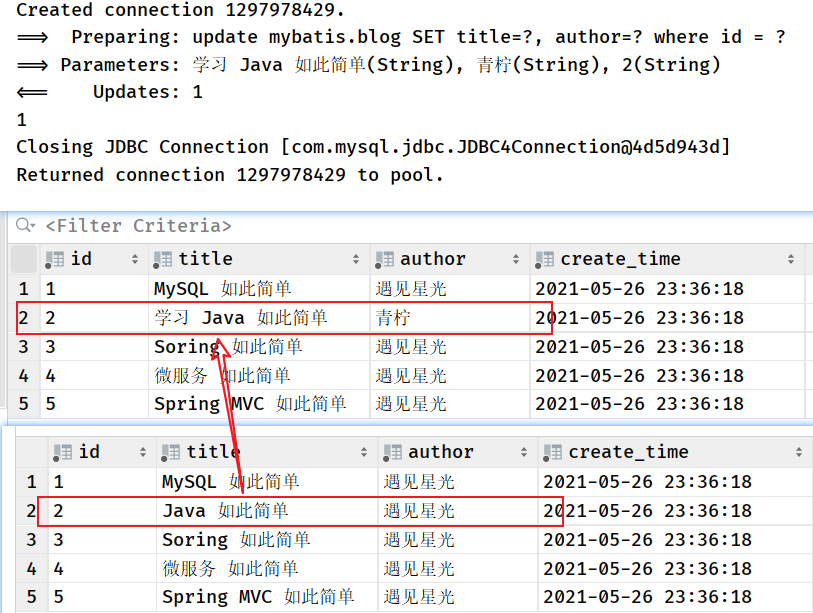什么是动态SQL:动态SQL就是根据不同的条件生成不同的SQL语句
如果你之前用过 JSTL 或任何基于类 XML 语言的文本处理器,你对动态 SQL 元素可能会感觉似曾相识。
在 MyBatis 之前的版本中,需要花时间了解大量的元素。
借助功能强大的基于 OGNL 的表达式,MyBatis 3 替换了之前的大部分元素,大大精简了元素种类,现在要学习的元素种类比原来的一半还要少。
CREATE TABLE `blog` (
`id` varchar(50) NOT NULL COMMENT ‘博客id‘,
`title` varchar(100) NOT NULL COMMENT ‘博客标题‘,
`author` varchar(30) NOT NULL COMMENT ‘博客作者‘,
`create_time` datetime NOT NULL COMMENT ‘创建时间‘,
`views` int(30) NOT NULL COMMENT ‘浏览量‘
) ENGINE=InnoDB DEFAULT CHARSET=utf8
导入依赖 【mysql驱动,Mybatis,junit,lombok】
编写配置文件 mybatis-config.xml
编写实体类Blog
@Data
@AllArgsConstructor
@NoArgsConstructor
public class Blog {
private String id;
private String title;
private String author;
private Date createTime; // 属性名和字段名不一致
private String views;
}
编写实体类对应的BlogMapper接口和 BlogMapper.xml 文件
Mybatis 配置文件中绑定 BlogMapper
解决属性名和字段名不一致:
Mybatis 配置文件中添加设置
mapUnderscoreToCamelCase 是否开启驼峰命名自动映射 true | false
<settings>
<setting name="mapUnderscoreToCamelCase" value="true"/>
</settings>
public class MybatisUtils {
static SqlSessionFactory sqlSessionFactory;
static {
String resource = "mybatis-config.xml";
try {
InputStream is = Resources.getResourceAsStream(resource);
sqlSessionFactory = new SqlSessionFactoryBuilder().build(is);
} catch (IOException e) {
e.printStackTrace();
}
}
public static SqlSession getSqlSession() {
return sqlSessionFactory.openSession(true);
}
}
BlogMapper
public interface BlogMapper {
// 插入数据
int addBlog(Blog blog);
}
BlogMapper.xml
<insert id="addBlog" parameterType="Blog">
insert into mybatis.blog(id, title, author, create_time, views)
values (#{id}, #{title}, #{author}, #{createTime}, #{views})
</insert>
测试
@Test
public void addBlog() {
SqlSession sqlSession = MybatisUtils.getSqlSession();
BlogMapper mapper = sqlSession.getMapper(BlogMapper.class);
Blog blog = new Blog();
blog.setId("1");
blog.setTitle("MySQL 如此简单");
blog.setAuthor("遇见星光");
blog.setCreateTime(new Date());
blog.setViews("10000");
mapper.addBlog(blog);
blog.setId("2");
blog.setTitle("Java 如此简单");
mapper.addBlog(blog);
blog.setId("3");
blog.setTitle("Soring 如此简单");
mapper.addBlog(blog);
blog.setId("4");
blog.setTitle("微服务 如此简单");
mapper.addBlog(blog);
blog.setId("5");
blog.setTitle("Spring MVC 如此简单");
mapper.addBlog(blog);
sqlSession.close();
}
结果

BlogMapper
public interface BlogMapper {
// 查询博客
List<Blog> queryBlogIF(Map map);
}
BlogMapper.xml
<select id="queryBlogIF" parameterType="map" resultType="Blog">
select * from mybatis.blog where 1=1
<if test="title!=null">
and title =#{title}
</if>
<if test="author!=null">
and author =#{author}
</if>
</select>
测试
@Test
public void queryBlogIF() {
SqlSession sqlSession = MybatisUtils.getSqlSession();
BlogMapper mapper = sqlSession.getMapper(BlogMapper.class);
Map<String, Object> map = new HashMap<String, Object>();
map.put("author","遇见星光");
map.put("title","Java 如此简单");
List<Blog> blogs = mapper.queryBlogIF(map);
for (Blog blog : blogs) {
System.out.println(blog.toString());
}
sqlSession.close();
}
结果


【注意】控制台的输出的其他信息是开启了日志功能
设置方法:
Mybatis 配置文件中添加设置
logImpl 指定 MyBatis 所用日志的具体实现,未指定时将自动查找。 LOG4J | STDOUT_LOGGING
<settings>
<setting name="logImpl" value="STDOUT_LOGGING"/>
</settings>
where 元素只会在子元素返回任何内容的情况下才插入 “WHERE” 子句。而且,若子句的开头为 “AND” 或 “OR”,where 元素也会将它们去除。
有时候,我们不想使用所有的条件,而只是想从多个条件中选择一个使用。针对这种情况,MyBatis 提供了 choose 元素,它有点像 Java 中的 switch 语句。
BlogMapper
public interface BlogMapper {
List<Blog> queryChoose(Map map);
}
BlogMapper.xml
<select id="queryChoose" parameterType="map" resultType="Blog">
select *
from mybatis.blog
<where>
<choose>
<when test="title!=null">
title=#{title}
</when>
<when test="author!=null">
and author=#{author}
</when>
<otherwise>
and views =#{views}
</otherwise>
</choose>
</where>
</select>
测试
@Test
public void queryChoose() {
SqlSession sqlSession = MybatisUtils.getSqlSession();
BlogMapper mapper = sqlSession.getMapper(BlogMapper.class);
Map<String, Object> map = new HashMap<String, Object>();
map.put("author","遇见星光");
map.put("title","Java 如此简单");
List<Blog> blogs = mapper.queryChoose(map);
for (Blog blog : blogs) {
System.out.println(blog.toString());
}
sqlSession.close();
}
结果

所谓的动态SQL,本质还是SQL语句,只是我们可以在SQL层面,去执行一个逻辑代码
set 元素会动态地在行首插入 SET 关键字,并会删掉额外的逗号(这些逗号是在使用条件语句给列赋值时引入的)。
<trim prefix="SET" suffixOverrides=",">
...
</trim>
注意,我们覆盖了后缀值设置,并且自定义了前缀值。
BlogMapper
public interface BlogMapper {
// 更新博客
int updateBlog(Map map);
}
BlogMapper.xml
<update id="updateBlog" parameterType="map">
update mybatis.blog
<set>
<if test="title!=null">
title=#{title},
</if>
<if test="author!=null">
author=#{author}
</if>
</set>
where id = #{id}
</update>
测试
@Test
public void updateBlog() {
SqlSession sqlSession = MybatisUtils.getSqlSession();
BlogMapper mapper = sqlSession.getMapper(BlogMapper.class);
Map<String, Object> map = new HashMap<String, Object>();
map.put("id", "2");
map.put("author", "青柠");
map.put("title", "学习 Java 如此简单");
int updateRows = mapper.updateBlog(map);
System.out.println(updateRows);
sqlSession.close();
}
结果

它也允许你指定开头与结尾的字符串以及集合项迭代之间的分隔符。这个元素也不会错误地添加多余的分隔符,看它多智能!
<where>
<!--
collection:遍历的集合 ids,
item 遍历出来的元素 id,
open:指定开头,
separator: 集合项迭代之间的分隔符,
close:指定结尾
and (id=2 or id=5)
-->
<foreach collection="ids" item="id" open="and (" separator="or" close=")">
id = #{id}
</foreach>
</where>
BlogMapper
public interface BlogMapper {
// 查询 指定 ID 记录的博客
List<Blog> queryByForeach(Map map);
}
BlogMapper.xml
<select id="queryByForeach" parameterType="map" resultType="Blog">
select *
from mybatis.blog
<where>
<foreach collection="ids" item="id" open="and (" separator="or" close=")">
id = #{id}
</foreach>
</where>
</select>
测试
@Test
public void queryByForeach() {
SqlSession sqlSession = MybatisUtils.getSqlSession();
BlogMapper mapper = sqlSession.getMapper(BlogMapper.class);
List<String> list = new ArrayList(); // 先定义一个集合 放ID
list.add("2");
list.add("5");
Map<String, Object> map = new HashMap<String, Object>();
map.put("ids", list);// 将集合添加到 Map 中
List<Blog> blogs = mapper.queryByForeach(map);
for (Blog blog : blogs) {
System.out.println(blog.toString());
}
sqlSession.close();
}
结果

有时候,我们可能将一些功能部分抽取出来,方便复用
<sql id="if-title-author">
<if test="title!=null">
and title =#{title}
</if>
<if test="author!=null">
and author =#{author}
</if>
</sql>
<select id="queryBlogIF" parameterType="map" resultType="Blog">
select * from mybatis.blog
<where>
<include refid="if-title-author"/>
</where>
</select>
注意事项:
动态SQL就是在拼接SQL语句,我们只要保证SQL的正确性,按照SQL的格式,去排列组合就可以了
建议:
原文:https://www.cnblogs.com/Right-A/p/14818057.html